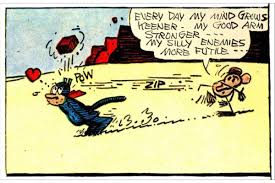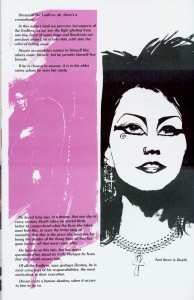Please do this for me. Don’t let Ted Turner deface my movie with his crayons
Orson Welles, to film director Henry Jaglom, 1989
Recolored comics have been all the rage in the last decade. Both Marvel and DC routinely release their collected editions with new colors, especially the classic comics from the 40s to the 80s, when comics were printed with a limited palette on cheap paper. With few exceptions, most of these coloring jobs look like crap, but that is a subjective opinion coming from someone who grew up with the pre-Image era acetate overlay-based coloring, with benday dots and all. There was a period of transition during the 80s, when the paper quality visibly changed, and some titles began to sport more garish tones than others. By the time Image released their books, and companies like Olyoptics and Digital Chameleon introduced lens flares and motion blur with their colors, thereby ensuring these maverick titles looked completely different from the regular superhero fare, the future of the industry was sealed.
At the same time, there began the trend of indie black-and-white comics getting reissued in color. Early examples were hit-and-miss, like Barry Blair’s Elflord, or First Comics releasing airbrushed deluxe editions of Eastman and Laird’s Teenage Mutant Ninja Turtles. Better results came about when creators took it on themselves to oversee the coloring. Jeff Smith’s Bone, and later, Rasl, were best-sellers in their color editions. Bryan Lee O’Malley’s Scott Pilgrim has found a new generation of enthusiasts once full-color editions came out. Even manga, the final frontier where two-color holds sway, has seen classics like Dragonball, One–Piece and Jojo’s Bizarre Adventure embracing digital coloring.
But when I received the news of From Hell: The Master Edition, I felt a disturbance in the Force. For one, the scratchy black-and-white artwork felt like the perfect style for a book that was set in the soot and fog of Victorian London. This was one of the rare works where the artist worked in tandem with the writer to create something so iconic, that any thought of a remaster felt like it was interfering with perfection. The plan, according to publishers IDW/Top Shelf Comics, was to have the seminal black-and-white comic recolored by Campbell himself. And that is part of what allayed my fears and made for less trepidation. The person approaching IDW with the idea was Eddie, and it looked like he knew the kind of changes he wanted to make. There was precedent — Brian Bolland did it with deluxe edition of The Killing Joke, because he felt John Higgins’ psychedelic palette was not what he had envisaged. I really loved the original colors on the Killing Joke, but I also liked Bolland’s version. So maybe it wouldn’t be that bad after all.
A short preview of the recolored pages showed promise, but there was still the nervousness that the color would ruin some of the mood of the minimalist, dream-like nature of some of the panels. That the splash of red in a gore-dripped sequence would detract from the strength of the scratchy black and white line-work.
By the time I was on the tenth chapter (volume 7 of the re-release, which compresses 14 chapters into 10 volumes), all my fears had vanished. This particular chapter is a creative high point between Campbell and Moore’s collaboration, occurring in one room in London’s East End, featuring Sir William Gull’s final act of cruelty against the last of the five women. It also jumps through time, both forwards and backwards, in the course of its 34 pages. Gull imagines himself in the presence of his long-dead friend James Hinton, who we last saw in chapter 2, and then in his capacity as surgeon, displaying his sanguinary skills to a shadowy array of onlookers.
The final hallucination is the one that jumps forward in time, where Gull finds himself transported in the middle of an office-space of cubicles and computers, in the twentieth century. This is the moment that sends shivers up my spine, and Moore’s words drip acid and venom at the state of the world.
It would seem we would suffer an apocalypse of cockatoos…Morose, barbaric children joylessly playing with their unfathomable toys. Where comes this dullness in your eyes? How has your century numbed you so? Shall man be given marvels only when he is beyond all wonder?
Alan Moore – From Hell
The attention to detail is spectacular. A pink-haired girl, the blue in the fluorescent lighting on the ceiling, the design pattern on a shirt sleeve peeking from a jacket. The dry-brush effects in the panels are intact. The subtle way in which the blood splatter effects are just the right shade of muted red, while the backgrounds remain a flat grey. That final panel in the page below is both grotesque and hypnotic. This feels like a reclaiming of Campbell’s artistic vision, brought to life by a virtuoso meld of technology and ambition.
I would love to talk about this series, in detail, once the final volume is out. I have tried to speak of it in the past, but not only were my words not sufficient, but I feel like a superficial essay does not do From Hell justice.










